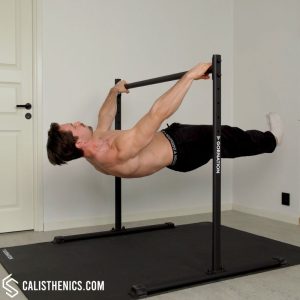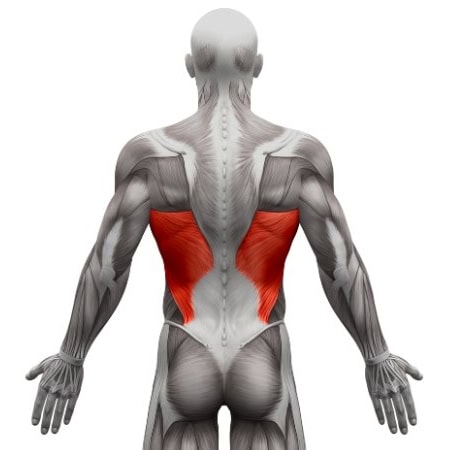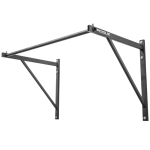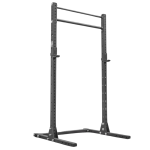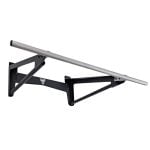Wide Front Lever
How to do Wide Front Lever?
The wide front lever is an advanced variation of the front lever where the athlete places their hands wider than shoulder-width on the bar while holding the body in a horizontal, parallel-to-the-ground position. This variation significantly increases the difficulty by reducing mechanical leverage, requiring greater lat engagement, shoulder stability, and overall core strength.
Check out our ▶️ front lever training routine to unlock the full front lever!
The equipment used is the ▶️ Static Bar from GORNATION --> For 10% off use code CS10.
CREDIT: This video was prepared in collaboration with calisthenics athlete Simon Imhäuser who was performing the exercise in the video and calisthenics coach Daniel Flefil who shot and edited the video.
Steps to Perform a Proper Wide Front Lever:
1. Grip the Bar Wider Than Shoulder Width:
• Grab the pull-up bar with an overhand (pronated) grip.
• Position your hands wider than shoulder width to increase difficulty and lat activation.
2. Engage Your Core and Lats:
• From a dead hang, depress your scapulae (shoulder blades down) to engage your lats and prevent unnecessary strain on your shoulders.
• Keep your arms fully extended throughout the movement.
3. Lift Your Body Into Position:
• Lean back while raising your legs, keeping them straight and together.
• Engage your core, glutes, and lower back to maintain a solid body line.
• Ensure your hips, shoulders, and feet are aligned parallel to the ground.
4. Hold the Position:
• Maintain full-body tension to prevent sagging or bending at the hips.
• Keep your arms locked and avoid excessive bending of the elbows.
• Focus on keeping your shoulders engaged and stable.
5. Lower Back to the Starting Position:
• Slowly lower your body back to a dead hang while maintaining control.
• Avoid swinging or using momentum.
6. Repeat the Movement:
• Perform multiple holds or repetitions, gradually increasing the duration of each hold as your strength improves.
Benefits of the Wide Front Lever
• Develops Superior Lat and Core Strength: Requires extreme lat engagement and core activation to hold proper alignment.
• Enhances Shoulder Stability: The wide grip places more demand on the shoulders, reinforcing strength and resilience.
• Progression Toward One-Arm Front Lever: The added difficulty of the wide grip helps build strength needed for the one-arm front lever.
• Builds Body Control and Coordination: Improves overall control, balance, and awareness of body positioning.
• Minimal Equipment Needed: Can be performed with just a pull-up bar or gymnastics rings.
Common Mistakes to Avoid
• Bending the Arms: Keep your elbows locked to prevent excess biceps engagement and maintain proper form.
• Shrugging the Shoulders: Maintain scapular depression to keep the shoulders engaged and avoid unnecessary strain.
• Arching the Back: Keep the spine neutral and the core engaged to prevent excessive lower back arching.
• Using Momentum: Perform slow and controlled movements rather than swinging into the position.
• Holding Your Breath: Breathe steadily to stay relaxed and maintain endurance during the hold.
Tips for the proper execution of Wide Front Lever
Full-Body Engagement: Keep your core, lats, glutes, and legs tight to maintain stability and alignment.
Scapular Depression: Keep your shoulders down and engaged to prevent strain and maximize strength output.
Controlled Movements: Avoid swinging into the position; focus on a slow and deliberate transition.
Neutral Head Position: Keep your head aligned with your spine, avoiding excessive neck extension.
Wider Grip Means Greater Challenge: The wider your grip, the harder the exercise will be due to the increased demand on your lats and shoulders.
Muscles worked when doing Wide Front Lever
Primary Muscles:
•Latissimus Dorsi (Lats): The primary muscle group controlling the movement and stabilizing the body.
•Core (Rectus Abdominis, Transverse Abdominis): Maintains spinal alignment and prevents the hips from sagging.
Secondary Muscles:
•Rhomboids and Trapezius: Assist in scapular depression and shoulder stabilization.
•Biceps: Work isometrically to support the arms in the hold.
•Erector Spinae: Engages to keep the back straight and resist gravitational pull.
•Glutes and Hip Flexors: Activate to hold the legs in a horizontal position.
Primary Muscle(s):
Secondary Muscle(s):
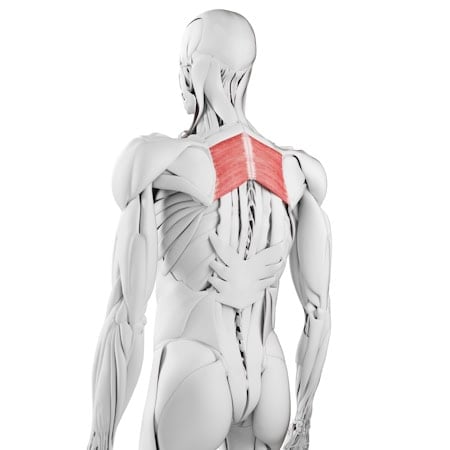
Rhomboid
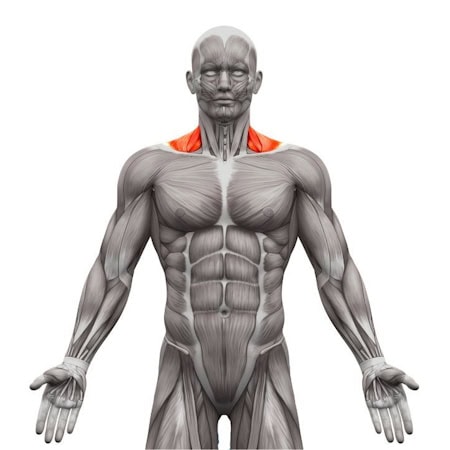
Trapezius
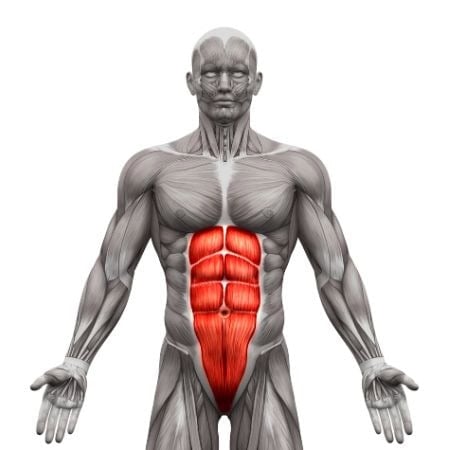
Abdominal
Adjust the difficulty of Wide Front Lever
How to make Wide Front Lever harder?
How to make Wide Front Lever easier?
How to make Wide Front Lever harder?
To make Wide Front Lever harder:
-
Increase Hold Duration: Extend the duration of the hold to build endurance and control.
-
Use an Even Wider Grip: The wider your grip, the greater the challenge on your lats and shoulders.
-
Add Controlled Repetitions: Instead of just holding the position, transition in and out of the wide front lever multiple times per set.
-
Perform Wide Front Lever Pulls: Start in a dead hang and pull yourself into the wide front lever position, then lower back down in a controlled manner.
-
Combine with Other Levers: Transition between different front lever variations, such as straddle to full, for an advanced progression.
-
Use a Weight Vest or Ankle Weights: Adding resistance increases the intensity and strengthens all engaged muscle groups.
How to make Wide Front Lever easier?
To make Wide Front Lever easier:
-
Use a Resistance Band: Loop a band around the pull-up bar and place it under your hips for support, reducing the load on your upper body.
-
Start with a Tucked or Advanced Tuck Position: Instead of keeping your legs straight, tuck them into your chest to decrease leverage and make the movement more manageable.
-
Perform Negatives (Slow Lowering): Instead of holding the position, focus on slowly lowering from the wide front lever to a dead hang to build strength.
-
Use a Closer Wide Grip: Start with a grip slightly wider than shoulder-width and gradually progress to an even wider grip over time.
-
Perform the Straddle Variation: Instead of keeping your legs together, straddle them to reduce the load on your core and back.

